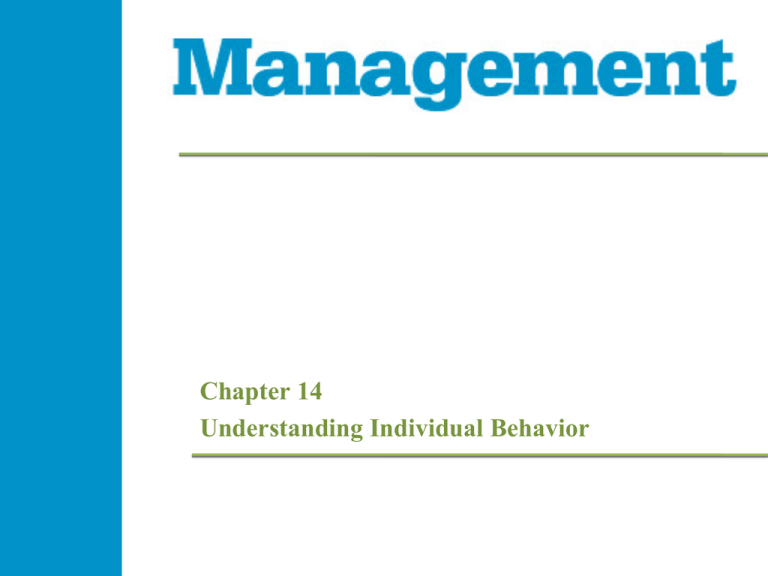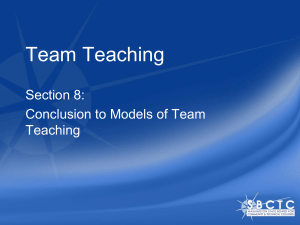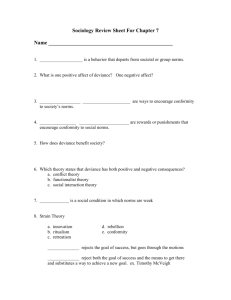
Chapter 14
Understanding Individual Behavior
Learning Objectives
Describe the dimensions of positive individual
behaviors and their impact on organizational
performance
Explain the characteristics of individual personalities
and strength profiles
Explain how individual attitudes and beliefs affect
team and organizational dynamics
Interpret how stress, deviance, and dysfunctional
behavior manifest and negatively affect team and
organizational performance
Design a plan for maximizing individual behavior to
change an organizational culture or performance
positively
Management 1e
14-- 2
How Individuals Make a Difference
(p. 352)
Positive psychology
• Explores ways to help people recognize their
positive traits or strengths, rather than their
perceived weaknesses and failings
• Abundance – conscious pursuit of purposeful
possibilities that are sustainable and stable over time
• In economically rough times, it is difficult to instill
the message of positive psychology
Management 1e
14- 3
How Individuals Make a Difference
(cont.)
Stress – physiological and emotional reactions
experienced by individuals to excessive
pressures or demands at work (p. 352)
• Consequences of stress
Absenteeism
Burnout
Negative affectivity – general dimension of personality
where an individual experiences negative mood states
Lowers likelihood of making contributions to the organization
• Even under adverse conditions, managers must try
to promote positive affectivity (p. 353)
Outward display of positive emotions
Management 1e
14- 4
How Individuals Make a Difference
(cont.)
Self-awareness (p. 353)
• Ability to look objectively at a circumstance and
make subjective, principle-based judgment
decisions simultaneously
• In order to make judgments about others, one must
be keenly aware of one’s own behavior
• Involves focusing on external relationships
• Mangers who practice self-awareness are more
likely to receive feedback from others, listen to
other perspectives, encourage communication, and
treat others fairly
Management 1e
14- 5
How Individuals Make a Difference
(cont.)
Purposeful thinking (p. 353)
• Involves continually seeking pathways for
possibilities and looking for opportunities to learn
and grow
• Linked to self-awareness
Relationships of thoughtful candor
• Candor – quality of being open, frank, and sincere
in speech or expression
• Must hold oneself responsible first, then others
• Show gratitude for the acts of others
Management 1e
14- 6
How Individuals Make a Difference
(cont.)
Challenging work (p. 354)
• Comprised of two types of tasks
Pleasureful tasks – provide an immediate feeling of joy
and delight, with little effect on overall life satisfaction
Purposeful tasks – provide a sense of accomplishment that
has lasting meaning
Moral courage
• Taking a position against something or someone even
though you know the outcome may be unpopular
• Involves taking risks
The probability of loss or undesirable consequences
Management 1e
14- 7
How Individuals Make a Difference
(cont.)
Joyful living (p. 354)
• Feelings and emotions defined by interest, passion,
curiosity, contentment, enthusiasm, satisfaction
and quality of life
• A measurable culmination of the other dimensions
of abundance, providing the means for progress
and motivation
Management 1e
14- 8
How Individuals Make a Difference
(cont.)
Power of perception and a positive approach (p. 354)
• Perception – process by which individuals select, interpret,
and organize information in the world around them
• Selective perception – process by which individuals accept
information consistent with their values and beliefs, while
screening out information that is not aligned with their own
needs
• Commitment – degree to which an employee is
psychologically devoted to an organization or team (p. 355)
• Confidence – certainty about handling something that a
person desires or needs to do
Management 1e
14- 9
How Individuals Make a Difference
(cont.)
Type A personality (p. 355)
• Behavioral pattern where individuals tend to be ambitious,
goal oriented, impatient, determined, highly organized,
competitive, and aggressive
Type B personality
• Behavioral pattern where individuals tend to be more
patient, relaxed, easygoing, and more sensitive to the
feelings of others
Psychological contract
• Informal expectation between employee and organization
that determines quality and satisfaction
Management 1e
14- 10
Personalities and Strengths (p. 356)
Stereotyping
• Tendency to ascribe characteristics or attributes to
a particular group or individual unfairly
Attribution
• Ascribed quality or characteristic that is related to
a particular individual or situation
Management 1e
14- 11
Personalities and Strengths (cont.)
“Big Five” personality traits (p. 357)
• Five broad domains of human psychology
Management 1e
14- 12
Personalities and Strengths (cont.)
Attitudes (p. 357)
• Person’s or group’s inclinations toward an idea or situation
Individual differences
• Variable psychological, behavioral, cultural, and physical
dimensions that uniquely distinguish each team member
Locus of control
• Degree to which an individual or team feels in control of
circumstances and outcomes
Internal – one feels in control of own fate
External – one feels that fate, rather than the actions of an
individual, controls outcomes in life
Management 1e
14- 13
Personalities and Strengths (cont.)
Authoritarianism (p. 358)
• Management philosophy that using the threat of punishment,
power, and legitimacy is required to produce superior results
• Less prevalent as organizations have adopted flatter structures
Machiavellianism
• Pragmatic management philosophy that condones unethical
and manipulative behavior if it produces desirable results
• Machiavellian leaders have little respect for their
subordinates, tend to take credit for their ideas, and rule with
fear
Management 1e
14- 14
Attitudes and Belief Systems (p. 361)
Cognitive dissonance
• Psychological strain that occurs when a person is
faced with two or more conflicting cognitions
(e.g., beliefs, attitudes, or items of knowledge)
Creativity
• Ability to devise innovative ideas to meet the
needs of a particular task or organizational goals
Management 1e
14- 15
Stress, Deviance, and Dysfunctional
Behavior (p. 363)
Dysfunctional behavior
• Actions that show a lack of commitment, lack of
trust, fear of confrontation or conflicting opinions, a
refusal to accept responsibility, and a tendency to
focus on their own individual needs ahead of the
team and organization
Deviance
• Intentional behavior and attitudes that differ from or
violate the accepted social norms
• Positive deviance – deviance that is honorable
Management 1e
14- 16
Stress, Deviance, and Dysfunctional
Behavior (cont.)
General adaptation syndrome (GAS; p. 364)
• Physiological reactions to long-term stress that can
be grouped into three stages: alarm, resistance, and
exhaustion
Citizenship
• Commitment to the overall functions of the team
and organizational culture in order to improve
performance
Management 1e
14- 17
Positive Deviance and Performance
(p. 365)
Emotional intelligence (EI; p. 366)
• Capacity to recognize and appreciate emotional
responses in one’s self and others
• EQ – managers who have insight into their own
emotions and the feelings of others can inspire a
higher quality of work performance
Requires getting substantial feedback from others to
increase self-awareness
Inducements
• Formal or informal agreements intended to entice
positive or desirable behaviors
Management 1e
14- 18
Copyright
Copyright © 2014 John Wiley & Sons, Inc.
All rights reserved. Reproduction or translation of this work
beyond that permitted in Section 117 of the 1976 United States
Copyright Act without express permission of the copyright owner
is unlawful. Request for further information should be addressed
to the Permissions Department, John Wiley & Sons, Inc. The
purchaser may make back-up copies for his/her own use only and
not for distribution or resale. The Publisher assumes no
responsibility for errors, omissions, or damages, caused by the
use of these programs or from the use of the information herein.
Management 1e
14-- 19




